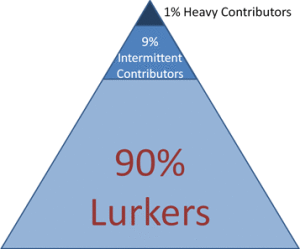 Sometimes it seems like more people are talking about Google+ than using it, but it really depends on the community you’re looking at. Comics fans? Not well represented. (But they’re even harder to find on Pinterest.) But “Bad Astronomer” Phil Plait has a thriving following.
Sometimes it seems like more people are talking about Google+ than using it, but it really depends on the community you’re looking at. Comics fans? Not well represented. (But they’re even harder to find on Pinterest.) But “Bad Astronomer” Phil Plait has a thriving following.
It seems like Speed Force’s Google+ Page is starting to attract a bit more participation, and I think that might be in part due to it passing the 100-follower mark. I vaguely recalled something about a 90-9-1 Rule for community involvement, which turned out to be pretty easy to find once I searched for it.
Basically, the rule states that:
- 90% of community members are “lurkers” who read or observe, but don’t contribute.
- 9% contribute occasionally (i.e. comment, “Like,” +1, share)
- 1% contribute frequently, and account for most contributions
These vary, with some communities having a higher participation rate than others, but the relative sizes of each group seem to track in my experience as well. The number of people who regularly comment on Speed Force’s social media pages is in low single digits on Google+ (>100 people have it in their circles) and Tumblr (>200 following), and upper single digits on Facebook (>800 fans) and Twitter (>1000 followers).
One implication here is that you need a big reading community before you can get a really robust conversation community, unless you start with a core that will eventually become that 1%.
Another is that a large number of non-posting users on Google+ (or any social network) isn’t necessarily a problem with the health of that network, because a lot of people will use it passively. Logged-in users on the site is probably a better measurement. (Besides, Google+ is more active than you probably think.)
The key takeaway from this is that if you look only at active participation, you’ll get a skewed view of the community, because a small segment — often those who have the strongest, most extreme opinions — tends to dominate the conversation. This applies to everything from product or business reviews to political commentary (which is kind of reassuring, actually). Take a look at reviews on Yelp or Amazon sometime: You’ll frequently see clusters of 5-star and 1-star reviews, because the people who most loved or most hated the experience were also the most motivated to share it.
Nielsen goes on to suggest that when you invert that pyramid, you find 90% of postings are from 1% of the community, and 10% of the postings are from 9%, leaving the remaining 90% of users completely unrepresented, and offers suggestions on how to increase the participation from that hidden 90%.
Wait, where have I seen that ratio before?
Oh, right.
90% of the comments are made by 1% of the people.


